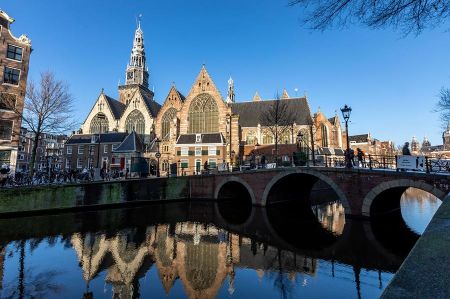Amsterdam and the De Wallen district – attractive but special
- Written by Portal Editor
During our tour of Amsterdam's De Wallen district, we quickly realized that the area is really very special, but it is as much a part of Amsterdam as the canals, the cheese and the incredible number of bicycles.
It is not for nothing that Amsterdam is considered particularly tolerant: the red-light district De Wallen, Amsterdam's China Town and the important Oude Kerk are also part of it. What is particularly interesting and very profound is the fact that countless tourists come here every day: they just come to have a look.
Chinatown, Red Light District and Oude Kerk
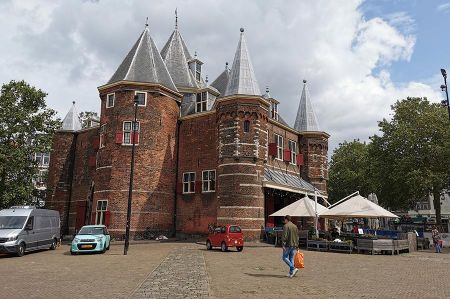 We rode our bikes from the campsite to the De Wallen district, then left the bikes safely secured in a bike parking space and went to the “Waag” castle tower (now a well-known restaurant); The striking building was to be our starting point again later.
We rode our bikes from the campsite to the De Wallen district, then left the bikes safely secured in a bike parking space and went to the “Waag” castle tower (now a well-known restaurant); The striking building was to be our starting point again later.
In 1488, a castle complex was built to defend the city called Sint Antoniespoort, which also served as a city gate. The area was expanded from 1614 and the defence system was converted into a weighbridge in 1617/1618. At that time the place was called Lastage.
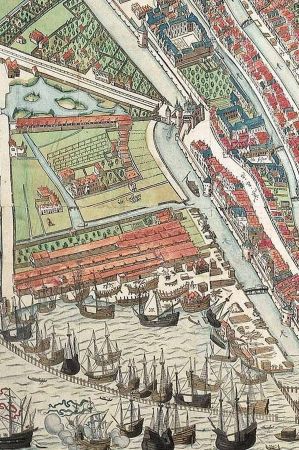 Part of the Kloveniersburgwal canal was drained to create a new market square, hence the name Nieuwmarkt. Initially it served as a cattle market and execution site; convicted criminals were put here to the guillotine. In the 14th century, the residents celebrated a folk festival on the Plein twice a year, which regularly ended in clashes. The community board then banned the fair attraction in 1876, which led to a “popular uprising”.
Part of the Kloveniersburgwal canal was drained to create a new market square, hence the name Nieuwmarkt. Initially it served as a cattle market and execution site; convicted criminals were put here to the guillotine. In the 14th century, the residents celebrated a folk festival on the Plein twice a year, which regularly ended in clashes. The community board then banned the fair attraction in 1876, which led to a “popular uprising”.
Amsterdam’s Chinatown begins right on the side street. The Chinese came to the city in the 1920s mainly as sailors. Today they have opened restaurants and supermarkets where you can try very good traditional Chinese cuisine. The He Hwa Buddhist Temple, which was built for the immigrants, is also located in the district.
Oude Kerk – a church right in the red-light district
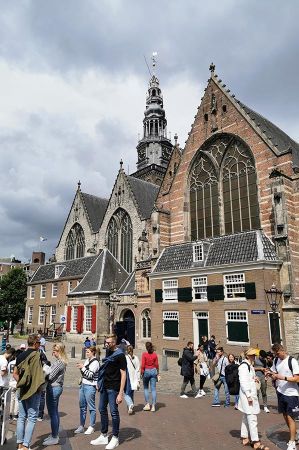 The location of the Oude Kerk alone is something special: you would hardly expect a church in the middle of the red-light district. But right here, between the scantily clad women in the shop windows, you will find the Oude Kerk, the oldest surviving building in the Dutch capital. Right next to the Oude Kerk is the old Bethany monastery on Nieuwemarkt. The monastery is still inhabited by nuns today.
The location of the Oude Kerk alone is something special: you would hardly expect a church in the middle of the red-light district. But right here, between the scantily clad women in the shop windows, you will find the Oude Kerk, the oldest surviving building in the Dutch capital. Right next to the Oude Kerk is the old Bethany monastery on Nieuwemarkt. The monastery is still inhabited by nuns today.
We were heading towards the old church, past coffee shops and brothels with scantily clad women sitting in the windows. The neighbourhood was one of the first in the world to allow prostitution. To this day, prostitutes can be found sitting in the windows of brothels. Amsterdam became known for these shop windows.
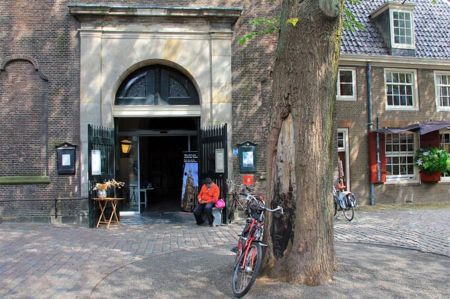 However, prostitution has been significantly restricted in the De Wallen in recent years. Since these measures, we can look forward to more visitors again! As a result, De Wallen was able to experience development into a trendy district.
However, prostitution has been significantly restricted in the De Wallen in recent years. Since these measures, we can look forward to more visitors again! As a result, De Wallen was able to experience development into a trendy district.
Here in the neighbourhood everyone is simply accepted for who they are. You can find gay and lesbian bars every few meters along the streets, but you can also enjoy small art studios or small alternative restaurants. Just take a quick look at a free exhibition and get to know a new artist better in the café - where is that possible?
Oude Kerk, the oldest building in Amsterdam.
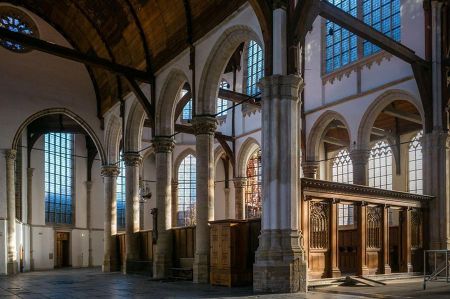 The church was built in the 13th century, when there was already a small chapel with a surrounding cemetery at its current location. As early as 1300, an independent parish church was built, which was designed by its builders as a Gothic hall church. Numerous smaller chapels were grouped around the hall church and a taller tower was also added. In the 15th century, however, iconoclasm reached the Oude Kerk, most of the interior of which was destroyed.
The church was built in the 13th century, when there was already a small chapel with a surrounding cemetery at its current location. As early as 1300, an independent parish church was built, which was designed by its builders as a Gothic hall church. Numerous smaller chapels were grouped around the hall church and a taller tower was also added. In the 15th century, however, iconoclasm reached the Oude Kerk, most of the interior of which was destroyed.
To this day, however, it has been preserved as a smaller church next to the "Nieuwe Kerk", which was built later. It was only when it was built that the "Oude Kerk" was given its name to indicate the church's special status as the oldest place of worship in the city. The Nieuwe Kerk was eventually elevated to the status of the coronation church of the Dutch kings. For the Oude Kerk, however, the red-light district remained as an environment, which became more and more established during this time. Today there are plans to locate more shops and restaurants around the church and thus move the red-light area less close to the church.
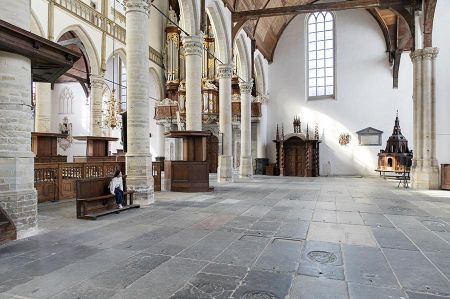 At first glance, the Oude Kerk's interior appears very simple, but a second look reveals some treasures: here are, among others, Saskia van Uylenburgh, the wife of the great artist Rembrandt, and the captain in his most important painting "The Night Watch", Frans Banning Cocq, buried. What is particularly special when visiting the church is the view of the organ from the 18th century. The musical instrument with the high number of 53 registers was built by a North German organ builder. Four bells ring in the church, symbolizing faith, love, hope and freedom. The church also houses a so-called carillon, a chime from France.
At first glance, the Oude Kerk's interior appears very simple, but a second look reveals some treasures: here are, among others, Saskia van Uylenburgh, the wife of the great artist Rembrandt, and the captain in his most important painting "The Night Watch", Frans Banning Cocq, buried. What is particularly special when visiting the church is the view of the organ from the 18th century. The musical instrument with the high number of 53 registers was built by a North German organ builder. Four bells ring in the church, symbolizing faith, love, hope and freedom. The church also houses a so-called carillon, a chime from France.
There is an entrance fee to visit the church, but this is within the normal range for the city and is largely used to maintain the church. In addition to church services, the Oude Kerk also hosts great organ concerts and one or two exhibitions worth seeing. It is often young artists who are allowed to exhibit in the church. They often work in the De Wallen district, where the Oude Kerk is located and which has gained attention in recent years for its lively art scene.
Also located in the De Wallen district you will find a secret church in an attic. Today the Amstel War Museum is located there, which is the second oldest museum in Amsterdam after the Reichsmuseum. The history of the attic church begins in the 17th century, when Catholic services were banned in Protestant Amsterdam. However, the followers of Catholicism were undeterred and held their services in the attic for more than 200 years. A fascinating story that the museum retells.
Please read as well:
